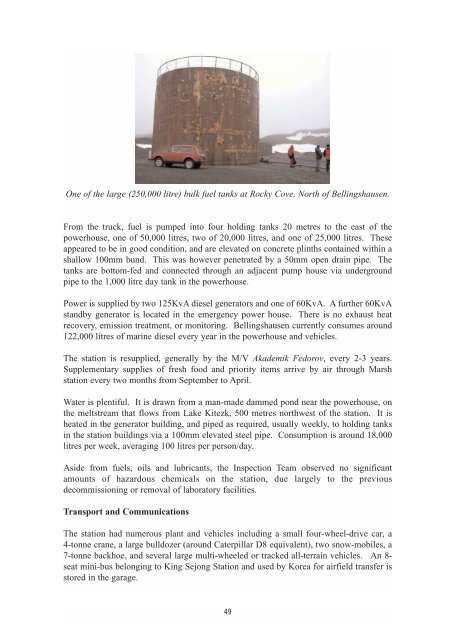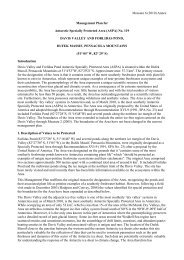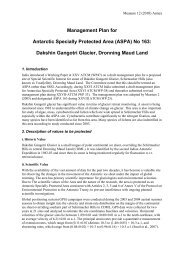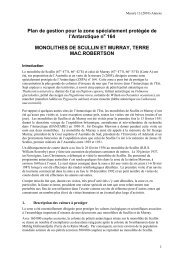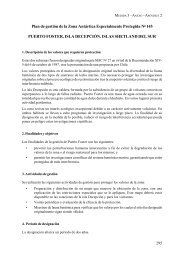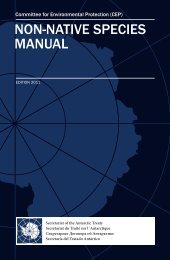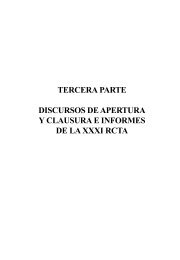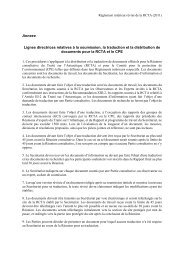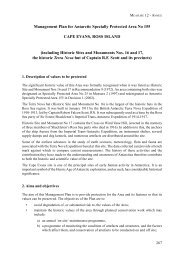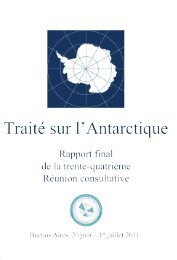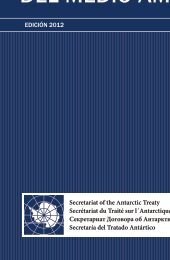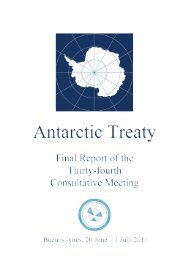Antarctic Treaty Inspections 2005 - Antarctic Treaty Secretariat
Antarctic Treaty Inspections 2005 - Antarctic Treaty Secretariat
Antarctic Treaty Inspections 2005 - Antarctic Treaty Secretariat
Create successful ePaper yourself
Turn your PDF publications into a flip-book with our unique Google optimized e-Paper software.
One of the large (250,000 litre) bulk fuel tanks at Rocky Cove, North of Bellingshausen.<br />
From the truck, fuel is pumped into four holding tanks 20 metres to the east of the<br />
powerhouse, one of 50,000 litres, two of 20,000 litres, and one of 25,000 litres. These<br />
appeared to be in good condition, and are elevated on concrete plinths contained within a<br />
shallow 100mm bund. This was however penetrated by a 50mm open drain pipe. The<br />
tanks are bottom-fed and connected through an adjacent pump house via underground<br />
pipe to the 1,000 litre day tank in the powerhouse.<br />
Power is supplied by two 125KvA diesel generators and one of 60KvA. A further 60KvA<br />
standby generator is located in the emergency power house. There is no exhaust heat<br />
recovery, emission treatment, or monitoring. Bellingshausen currently consumes around<br />
122,000 litres of marine diesel every year in the powerhouse and vehicles.<br />
The station is resupplied, generally by the M/V Akademik Fedorov, every 2-3 years.<br />
Supplementary supplies of fresh food and priority items arrive by air through Marsh<br />
station every two months from September to April.<br />
Water is plentiful. It is drawn from a man-made dammed pond near the powerhouse, on<br />
the meltstream that flows from Lake Kitezk, 500 metres northwest of the station. It is<br />
heated in the generator building, and piped as required, usually weekly, to holding tanks<br />
in the station buildings via a 100mm elevated steel pipe. Consumption is around 18,000<br />
litres per week, averaging 100 litres per person/day.<br />
Aside from fuels, oils and lubricants, the Inspection Team observed no significant<br />
amounts of hazardous chemicals on the station, due largely to the previous<br />
decommissioning or removal of laboratory facilities.<br />
Transport and Communications<br />
The station had numerous plant and vehicles including a small four-wheel-drive car, a<br />
4-tonne crane, a large bulldozer (around Caterpillar D8 equivalent), two snow-mobiles, a<br />
7-tonne backhoe, and several large multi-wheeled or tracked all-terrain vehicles. An 8-<br />
seat mini-bus belonging to King Sejong Station and used by Korea for airfield transfer is<br />
stored in the garage.<br />
49


